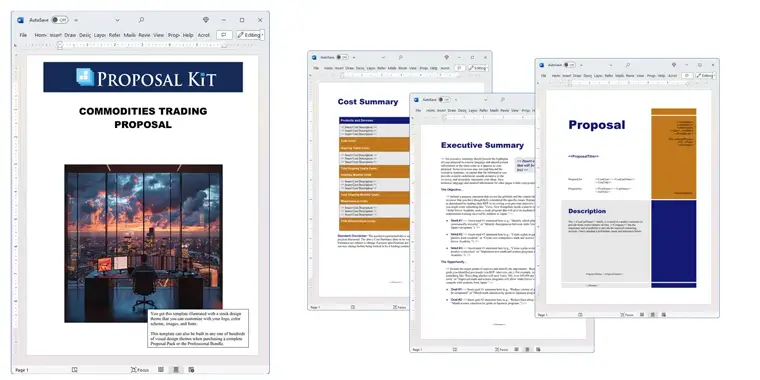How to write your Commodities Trading Proposal
We include this 14 page layout with every Proposal Pack. If you want this template to have a different visual design theme than the one illustrated here, purchase any Proposal Pack design and create this template using the purchased design theme. This template is included in every Proposal Pack. If you get a Proposal Pack or the Professional, you can also make any variation of this template with different chapters to suit your needs.
We typically include more chapters in the templates than most people will need to give everyone more variety in the chapters they may need. You can trim down a long template by removing pages you do not need or combining multiple chapter topics into one page.
 DOWNLOADABLE, ONE-TIME COST, NO SUBSCRIPTION FEES
DOWNLOADABLE, ONE-TIME COST, NO SUBSCRIPTION FEESYou can also create countless variations of this document to suit your needs using the included library of 2200+ chapters if ordering a Proposal Pack or Professional.
 What Our Clients Say
What Our Clients SayGot a large deal with my first proposal using your system. Love it!"
Related Article
Related Video
Related Templates
- Commodities Trading Imports and Exports Proposal
- Investment and Brokerage Services Proposal
- Investment Strategy Proposal
- Asset Management Services Proposal
- Financial Prospectus
- Minimizing Tariff Exposure Proposal Template
Commodities Trading Proposals with Proposal Kit
Creating a compelling commodities trading proposal can seem daunting, especially for those unfamiliar with how to write one. However, Proposal Kit's innovative software and template library simplifies the process, offering a step-by-step guide to writing a detailed and persuasive document. Proposal Kit has everything needed to succeed in writing a winning proposal.
You're not alone if you're facing the challenge of writing a commodities trading proposal. The Proposal Kit is designed to help you write a standout document.
What Types of Projects Are Commodities Trading Proposals Written For?
Commodities trading covers many projects, each requiring a unique approach. Examples include:
- Gold and precious metals trading
- Oil and energy commodities transactions
- Agricultural products trading, such as grains and livestock
- Metals and minerals trading
- Energy futures contract proposals
- Foreign exchange commodities trading
- Renewable energy certificates trading
- Carbon credits trading
- Water rights trading
- Soft commodities trading, like coffee and sugar
Chapters this template is built with
Proposal Kit provides a comprehensive suite of templates and tools tailored for the financial services industry. Here's how specific chapters can be utilized in your proposal.
By expanding on these topics with detailed analysis, data-backed arguments, and a straightforward narrative, your commodities trading proposal will effectively communicate the value and expertise your financial services firm brings to the table, setting the stage for a successful partnership.
These templates, just a tiny selection of what's available in the Proposal Kit, allow you to customize your proposal to cover all necessary topics.
Cover Letter
Your cover letter should serve as a warm introduction to your financial services firm. Express your excitement about the potential trading opportunity and highlight your firm's unique qualifications and passion for commodities trading. This section sets the tone for the proposal, aiming to establish a connection with the recipient and generate interest in the following detailed content.
Introduction
The Introduction should provide a concise yet comprehensive overview of the commodities market, setting the stage for the specific opportunity you're presenting. Outline the current market trends, the economic factors at play, and how these create a ripe environment for your trading strategy. This section should capture the reader's attention by emphasizing the opportunity's timeliness and relevance.
Your Investment
Detail the required initial investment, breaking down the components contributing to the total cost. Then, outline the potential returns, using market data and historical performance as benchmarks. This section should balance realism and optimism, providing a clear picture of what the investor can expect regarding financial commitment and potential gains.
Opportunities
Highlight specific trading opportunities within the commodities market, focusing on those with high growth potential or favorable risk-reward ratios. Use data and analysis to support your claims, showing why these opportunities stand out and how they align with the overall trading strategy and market conditions.
Growth Areas
Analyze sectors within commodities trading that are poised for growth, such as renewable energy commodities, precious metals in times of economic uncertainty, or agricultural commodities driven by global demand trends. This analysis should provide a rationale for focusing on these areas, supported by market research and forecasts.
Trading
Describe your proposed trading strategy in detail, explaining how it will benefit your client. This should include the criteria for selecting commodities, timing for buy/sell decisions, and how the strategy adapts to changing market conditions. Highlight the expertise and experience that enable your firm to execute this strategy effectively.
Risk Analysis
Provide a thorough assessment of the potential risks associated with your trading strategy, including market volatility, geopolitical factors, and specific risks related to the commodities being traded. Detail your firm's mitigation strategies, such as diversification, hedging, and strict risk management protocols, to reassure the client of your commitment to protecting their investment.
Commodities
Offer in-depth information on the specific commodities you propose to trade, including their market dynamics, supply and demand factors, and historical performance. This section should underscore your firm's expertise in these commodities and why they present a compelling investment opportunity.
Recommendations
Based on the client's investment goals and risk tolerance, provide tailored advice on allocating their investment across the trading opportunities identified. This personalized approach demonstrates your firm's commitment to aligning its trading strategies with the client's financial objectives.
Conclusions
Summarize your proposal's key points, reiterating the trading strategy's value and potential returns. This concluding section should give the reader a clear understanding of the opportunity's merits and your firm's ability to capitalize on it.
Company History
Share your financial services firm's history and success stories, emphasizing your track record in commodities trading. Highlight any awards, recognitions, or significant achievements that build credibility and trust. This section assures the client of your firm's stability, expertise, and capacity to deliver on the promises made in the proposal.
Use cases for this template
Tara's Strategic Win with Zenith Trading Solutions
Tara faced the challenge of convincing a hesitant investor that her trading strategy was viable and potentially lucrative. She turned to the Proposal Kit, which offered her a structured way to present her ideas. Tara began with a clear overview of the commodities market, using the Introduction template to set the stage. She detailed her trading strategy, emphasizing its unique approach to leveraging market inefficiencies. The Your Investment and Opportunities sections allowed her to paint a picture of the potential returns backed by historical data and market analysis.
Tara knew that risk management was a crucial concern for her investor. Using the Risk Analysis template, she meticulously outlined her firm's measures to mitigate risks, including diversification strategies and stop-loss orders. This comprehensive approach, facilitated by Proposal Kit's templates, enabled Tara to present a compelling case that addressed the investor's concerns and showcased the strategic thought behind her trading plans. The result was not just winning the investment but also establishing a foundation of trust and transparency that set Zenith Trading Solutions up for future success.
Leo's Deadline Achievement at Orion Commodities
Leo's task was daunting: a comprehensive commodities trading proposal with a rapidly approaching deadline. The synergy between the Proposal Kit and an AI writing tool became his solution. The Proposal Kit gave him a roadmap, starting with the Cover Letter to introduce Orion Commodities' commitment to innovative trading solutions. The AI tool, fed with data from the company's website, generated initial drafts for sections like Company History and Trading, which Leo then refined using Proposal Kit's templates.
The Opportunities and Growth Areas sections were pivotal, allowing Leo to showcase the firm's insights into emerging market trends and high-potential commodities. His detailed Risk Analysis demonstrated a proactive approach to managing potential market volatilities, reassuring his superiors of the proposal's solid foundation. The seamless integration of content, strategy, and presentation, underscored by Proposal Kit's framework, helped Leo meet his deadline. The proposal secured a significant contract and highlighted Leo's ability to deliver under pressure, bolstering his position within Orion Commodities.
Nadia's Global Outreach with International Trade Corp
Nadia's challenge was writing an RFP for a commodities trading initiative that spanned across borders. The global scope required a document that was both comprehensive and inviting to detailed bids from potential trading partners. Proposal Kit's structured templates enabled her to clearly outline International Trade Corp's objectives, starting with the Introduction and moving into detailed sections on Commodities and Trading strategies.
Utilizing the Opportunities template, Nadia highlighted specific areas of interest for the trading initiative, encouraging prospective bidders to align their proposals with these areas. The Company History section established International Trade Corp's credibility and experience in global commodities trading, reassuring potential partners of the corporation's capability to manage such a vast project.
The final RFP, written with the aid of Proposal Kit, was a testament to Nadia's thorough understanding of the project's requirements and her ability to communicate them effectively. It attracted competitive bids from reputable trading firms, laying the groundwork for a successful partnership that would enhance International Trade Corp's position in the global market. This achievement showcased Nadia's strategic and organizational skills and demonstrated Proposal Kit's versatility in facilitating international business engagements.
Conclusions and Recommendations
From Tara's strategic approach to securing investment to Leo's successful navigation of a tight deadline to Nadia's execution of a complex international RFP, Proposal Kit has proven to be an invaluable asset. These situations demonstrate how Proposal Kit can transform the challenging task of writing a commodities trading proposal into a manageable, successful endeavor.
Proposal Kit empowers financial services professionals to create compelling, winning commodities trading proposals by offering a structured, detailed guide and a comprehensive template library. Remember, the key to success in commodities trading lies in the strength of your proposal.
Also Known As
This template may also be referred to in different ways or be used in more specialized situations, such as:
- Raw Materials Exchange Plan
- Futures Trading Strategy
- Natural Resources Trading Initiative
- Agricultural and Metals Trading Scheme
- Commodity Market Investment Proposal
- Bulk Goods Trading Blueprint
- Resource Allocation Strategy
- Commodity Futures Investment Plan
- Trade Commodities Proposal
- Primary Goods Trading Project
Abstract
 Commodities trading is a complex and dynamic field that involves buying, selling, and exchanging tangible goods like agricultural products, metals, and energy resources. The commodities trading landscape is constantly driven by factors such as market demand, price fluctuations, and industry events.
Commodities trading is a complex and dynamic field that involves buying, selling, and exchanging tangible goods like agricultural products, metals, and energy resources. The commodities trading landscape is constantly driven by factors such as market demand, price fluctuations, and industry events.
Traders and market participants engage in commodity transactions to capitalize on market opportunities, using their market knowledge and expertise. A detailed business plan and clear audit trail are important for ensuring regulatory compliance with relevant laws and CFTC regulations. Smart contracts and a thorough risk assessment help mitigate potential issues, such as non-payment and market volatility.
In the field of commodities trading, understanding the role of key market participants is vital. Commodity traders, banks, and legal experts work together to facilitate trades, using financial instruments like swaps and futures contracts. These trades are often conducted on exchanges where liquidity and capital flow smoothly. Companies must develop strong relationships with suppliers and customers to ensure the seamless operation of trading activities across different countries. Financing options, such as loans and insurance policies, are crucial in managing financial obligations and ensuring the availability of funds.
 Price fluctuations in commodity markets can significantly impact businesses and investors. Therefore, a robust risk management strategy that includes diversification and hedging is important. Businesses must stay informed about market trends, industry events, and regulatory changes to maintain a competitive edge. By building relationships with intermediaries and maintaining a strong understanding of market economics, companies and traders can confidently navigate the commodities trading landscape, achieving profitability and growth.
Price fluctuations in commodity markets can significantly impact businesses and investors. Therefore, a robust risk management strategy that includes diversification and hedging is important. Businesses must stay informed about market trends, industry events, and regulatory changes to maintain a competitive edge. By building relationships with intermediaries and maintaining a strong understanding of market economics, companies and traders can confidently navigate the commodities trading landscape, achieving profitability and growth.
Commodities trading serves an important role in global markets, influencing various industries and economies. The main categories of commodities include energy resources like natural gas, agricultural products such as corn, and precious metals. Market participants, including commodity traders, producers, and consumers, play a vital role in determining commodity prices through supply and demand dynamics. These prices are influenced by a range of factors, including interest rates, inflation, and geopolitical events, which can lead to significant price fluctuations. By keeping track of these key factors and staying informed about industry events, traders can make informed decisions that align with their business plans.
Successful trading operations require an approach to determine when to buy or sell commodities. This involves analyzing performance metrics and financial statements to assess market conditions and the feasibility of different trading strategies. The Commodity Futures Trading Commission (CFTC) regulations and relevant laws ensure a framework for maintaining transparency and integrity in futures trading. Through smart contracts, businesses can ensure compliance and establish a clear audit trail, promoting trust and security in commodity transactions.
 Market knowledge is enhanced by valuable insights gained from trade shows and industry conferences where companies exchange ideas and learn about emerging trends. Additionally, fostering strong relationships with banks, lenders, and other market intermediaries can enhance access to capital and credit, providing necessary funds to finance operations and leverage opportunities. Insurance policies and collateral arrangements also play a significant role in protecting against potential risks such as non-payment or transportation challenges.
Market knowledge is enhanced by valuable insights gained from trade shows and industry conferences where companies exchange ideas and learn about emerging trends. Additionally, fostering strong relationships with banks, lenders, and other market intermediaries can enhance access to capital and credit, providing necessary funds to finance operations and leverage opportunities. Insurance policies and collateral arrangements also play a significant role in protecting against potential risks such as non-payment or transportation challenges.
In the field of commodity trading, diversifying portfolios by engaging in swaps and using futures contracts can hedge against adverse price movements. Developing a detailed business plan that outlines key strategies, risk assessment protocols, and growth opportunities is important for businesses to thrive. By focusing on key areas such as renewable energy and agricultural commodities, companies can capitalize on market demand and generate substantial revenues. Through careful monitoring of economic indicators and regulatory changes, commodity traders can maintain a competitive edge and achieve sustained profitability in different countries and regions.
Frequently Asked Questions
What should a commodities trading proposal include?
A commodities trading proposal should include an executive summary, market analysis, objectives and goals, trading strategies, risk management plans, and financial projections. The executive summary provides a snapshot of the proposal, while the market analysis offers insights into current market conditions and trends. Objectives and goals define what you aim to achieve, and trading strategies outline the methods you plan to use. Risk management plans detail how you will mitigate potential losses, and financial projections estimate future performance and profitability.
How do I conduct a market analysis for my commodities trading proposal?
To conduct a market analysis, start by researching current market trends, demand and supply factors, and pricing histories for the commodities you plan to trade. Use industry reports, financial news, and market data platforms to gather relevant information. Analyze competitor strategies and identify key market drivers and challenges. This analysis will provide a comprehensive understanding of the market landscape, enabling you to make informed trading decisions and position your proposal effectively.
What are effective risk management strategies for commodities trading?
Effective risk management strategies in commodities trading include diversification, hedging, and setting stop-loss orders. Diversification involves spreading investments across different commodities to reduce exposure to any single market fluctuation. Hedging uses financial instruments like futures contracts to offset potential losses. Stop-loss orders automatically sell a commodity when its price reaches a predetermined level, limiting losses. Implementing these strategies helps manage risk and protect your investments against market volatility.
How do I create realistic financial projections for my commodities trading proposal?
Creating realistic financial projections involves estimating potential revenue, costs, and profits based on current market conditions and historical data. Start by forecasting the price movements of the commodities you intend to trade and their potential impact on your portfolio. Calculate net profits by incorporating trading fees, transaction costs, and other expenses. Use conservative assumptions to avoid overestimating returns. Regularly update projections based on market changes and actual performance to maintain accuracy.
What are common mistakes to avoid when writing a commodities trading proposal?
Common mistakes include failing to conduct thorough market research, underestimating risks, overestimating returns, and needing a clear strategy. Skimping on market analysis can lead to uninformed trading decisions, while not having a robust risk management plan can result in significant losses. Over-optimistic financial projections can undermine credibility and lead to realistic expectations. A clear, well-defined trading strategy is essential for guiding decision-making and achieving objectives. Avoiding these pitfalls ensures a more robust, more viable proposal.
20% Off Discount
![]() Add To Cart This Word Template
Add To Cart This Word Template
 Add To Cart Proposal Pack for Any Business
Add To Cart Proposal Pack for Any Business
 Add To Cart Proposal Kit Professional
Add To Cart Proposal Kit Professional
 4.7 stars, based on 849 reviews
4.7 stars, based on 849 reviewsProposal Kit chapters used in this template
Cover Letter, Title Page, Table of Contents, Introduction, Opportunities, Growth Areas, Your Investment, Commodities, Trading, Risk Analysis, Conclusions, Recommendations, Company History, Back Page
Line Item Automated Chapters
If you purchase a Proposal Pack or the Professional Bundle, these proposal pages are generated using an automated line-item database in the included Wizard software.
Your Investment
You use this proposal for
- General business proposal
- Non-technical proposal
- Business opportunity, partnership proposal
- Financial, investment, legal proposal
How to create this template with Proposal Pack Wizard
You can create this document using any of the logo-designed Proposal Packs. Pick any Proposal Pack with a logo design theme you like best; they will all work equally well. The Proposal Pack for Any Business is the pack with no extra added logos or colors - designed to be used plain or for you to customize with your logos and graphics.
The Proposal Pack design theme you purchase will determine the visual look of this template. The screenshot above only shows the plain generic design theme.
We include a library of chapters to be assembled based on your needs. All proposals are different and have different needs and goals. We designed Proposal Pack so you can customize the documents to suit your needs.
You will best create this document using the Proposal Pack Wizard - Expert Edition software to select this template and build it in the Proposal Pack logo design theme of your choice along with any desired customizations (such as adding additional chapters, removing unneeded chapters, changing the order of chapters, and importing your company logo). This template outlines a proposal for the described situation. Each user is responsible for typing in the actual content of the provided pages with their information to complete the proposal. Suggestions in the abstract may include features in higher-end packages and are facilitated by the selection of chapter templates to support the narrative of each proposal, which help guide the user in filling in the details.
The Wizard software's AI Writer will write the content of the pages of the template based on details provided for your company, client, project, financial details and other writing instructions. This will provide a personalized version of the template completely written and ready to edit.
Once finished, the AI Writer's Word-to-PowerPoint converter can transform your proposal, business plan, or other business documents into a PowerPoint slideshow. Save time and effort by letting the AI analyze every chapter to condense its content into talking points, visually matching the document, and providing a consistent package of presentation material with the click of a button.
You create this template using the Wizard software with an entire Proposal Pack library and software. We include the Expert Edition of the software in the Proposal Kit Professional. Microsoft Word for Windows is required to use the customizing software. You can also edit Word document templates in other office software such as Word for Mac. We will assist Mac users in assembling complex templates for their first project if they do not have the required platform to run the Wizard software.
How to Build Templates Featured on Proposal Kit Website
Many people find the Proposal Kit website after searching for a specific proposal. Once you've purchased and installed the software, how do you build that template you found in the first place? This video shows you how to build any proposal you see on the Proposal Kit website.
 Ian Lauder has been helping businesses write their proposals and contracts for two decades. Ian is the owner and founder of Proposal Kit, one of the original sources of business proposal and contract software products started in 1997.
Ian Lauder has been helping businesses write their proposals and contracts for two decades. Ian is the owner and founder of Proposal Kit, one of the original sources of business proposal and contract software products started in 1997.By Ian Lauder
 Published by Proposal Kit, Inc.
Published by Proposal Kit, Inc.


 Cart
Cart
 Get 20% off ordering today:
Get 20% off ordering today: 


 Facebook
Facebook YouTube
YouTube Bluesky
Bluesky Search Site
Search Site